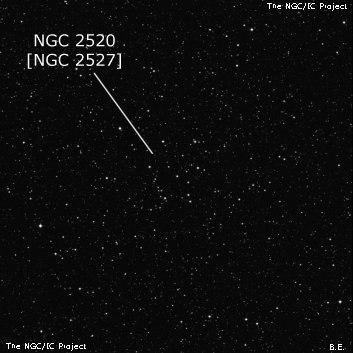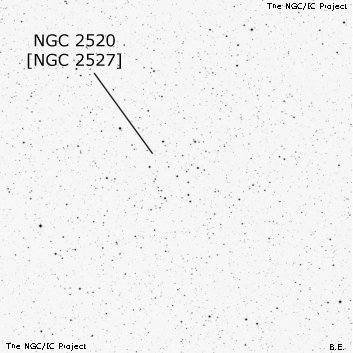NGC/IC Project Restoration Effort
(This is a very very beta version)
NGC2520


Basic Information
Location and Magnitude
Right Ascension: 8:4:58.1
Declination: -28:8:46
Constellation: PUP
Visual Magnitude: 6.5
Historic Information
Discoverer: Herschel J.
Year of discovery: 1837
Discovery aperture: 18.3
Observational
Summary description: Cl, B, pRi, pC
Sub-type: III1p
Corwin's Notes
=====
NGC 2520 = NGC 2527. JH has two observations of the cluster, one from Slough,
the other from the Cape, both clearly of the same object. The RA of the
earlier observation from Slough is marked "+-" and noted "... by working
list." So, even though the RA for the Cape observation is out by 2.5 minutes
of time, JH believed his own later RA rather than the one from his aunt's
reduction of his father's observation. Given the possibility that there
actually were two clusters rather than just one, JH included both positions in
the GC. Dreyer of course, just carried both on over to the NGC.
We can identify the cluster in the Cape Observations with no ambiguity,
though, from JH's description of it: "Cluster 7th class, distinguished among
milky way clusters; p rich; bright. The star taken is the chief of a
condensed hook in the following part." The hook stands out clearly, and JH's
RA turns out to be exactly 2.5 minutes of time smaller than the star's.
However, even WH's RA is about 40 seconds of time too large, and his
declination is about 14 arcmin too far north. Since there is a mild
concentration of stars at his position, the possibility remains that there
really are two clusters involved, though one is not one of those that JH had
in mind.
The Herschels did not do too well with this cluster, so we are left with a bit
of a puzzle as well. In the end, I've taken the one cluster that we can
identify with some confidence.
Steve's Notes
=====
NGC 2520
See observing notes for NGC 2527. Incorrect position in the RNGC.



